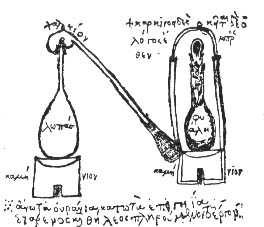Alembic
Alembic is an apparatus used for distillation of liquids through the process of heating and cooling. The device is of ancient origin, with evidence of its use dating back to the alchemical traditions of the Middle East and later in medieval Europe. The alembic has played a crucial role in the development of chemistry, pharmacy, and the creation of perfumes and alcoholic beverages.
History[edit | edit source]
The alembic is thought to have been invented by Mary the Jewess in around the 1st to 3rd centuries AD, making it one of the earliest pieces of laboratory equipment. It was initially used by alchemists in their quest to transform base metals into gold and to find a universal elixir of life. The word "alembic" itself comes from the Arabic al-anbiq, which means "the still," derived from the Greek ambix, meaning "cup" or "pot". Its design and function have evolved over centuries, but its primary purpose for distillation has remained the same.
Design and Function[edit | edit source]
The traditional alembic consists of three parts: the pot, where the initial substance is heated; the condenser, where the vapor cools and condenses back into liquid; and the receiver, where the distilled liquid is collected. The pot is often made from copper for its excellent thermal conductivity, while the condenser is typically made from a material that easily transfers heat, such as glass or copper.
In the process of distillation, the alembic is used to separate liquids based on differences in their boiling points. This is achieved by heating the liquid in the pot to create vapor, which then travels into the condenser. As the vapor cools, it condenses back into liquid form and is collected in the receiver. This method is particularly useful for purifying a liquid by removing impurities or for separating components in a mixture.
Applications[edit | edit source]
The alembic has a wide range of applications across various fields. In pharmacy, it is used to distill essential oils and alcohol, which are then used in the preparation of medicines. In the beverage industry, it is employed in the production of spirits such as whiskey, rum, and brandy. The alembic is also used in the perfumery industry to extract fragrances from plants and flowers.
Cultural Significance[edit | edit source]
The alembic is not only a tool for scientific and industrial processes but also holds a significant place in cultural and historical contexts. It symbolizes the alchemical quest for knowledge and the transformation of materials, a theme prevalent in literature and art related to alchemy. The alembic's iconic shape is often associated with the mystical and the arcane, making it a popular motif in works that explore themes of transformation and discovery.
Modern Usage[edit | edit source]
While modern distillation equipment has evolved, the alembic still finds use in artisanal and traditional practices, especially in the production of spirits and essential oils. Its enduring presence attests to the ingenuity of ancient technologies and their continued relevance in contemporary applications.
Search WikiMD
Ad.Tired of being Overweight? Try W8MD's physician weight loss program.
Semaglutide (Ozempic / Wegovy and Tirzepatide (Mounjaro / Zepbound) available.
Advertise on WikiMD
|
WikiMD's Wellness Encyclopedia |
| Let Food Be Thy Medicine Medicine Thy Food - Hippocrates |
Translate this page: - East Asian
中文,
日本,
한국어,
South Asian
हिन्दी,
தமிழ்,
తెలుగు,
Urdu,
ಕನ್ನಡ,
Southeast Asian
Indonesian,
Vietnamese,
Thai,
မြန်မာဘာသာ,
বাংলা
European
español,
Deutsch,
français,
Greek,
português do Brasil,
polski,
română,
русский,
Nederlands,
norsk,
svenska,
suomi,
Italian
Middle Eastern & African
عربى,
Turkish,
Persian,
Hebrew,
Afrikaans,
isiZulu,
Kiswahili,
Other
Bulgarian,
Hungarian,
Czech,
Swedish,
മലയാളം,
मराठी,
ਪੰਜਾਬੀ,
ગુજરાતી,
Portuguese,
Ukrainian
Medical Disclaimer: WikiMD is not a substitute for professional medical advice. The information on WikiMD is provided as an information resource only, may be incorrect, outdated or misleading, and is not to be used or relied on for any diagnostic or treatment purposes. Please consult your health care provider before making any healthcare decisions or for guidance about a specific medical condition. WikiMD expressly disclaims responsibility, and shall have no liability, for any damages, loss, injury, or liability whatsoever suffered as a result of your reliance on the information contained in this site. By visiting this site you agree to the foregoing terms and conditions, which may from time to time be changed or supplemented by WikiMD. If you do not agree to the foregoing terms and conditions, you should not enter or use this site. See full disclaimer.
Credits:Most images are courtesy of Wikimedia commons, and templates, categories Wikipedia, licensed under CC BY SA or similar.
Contributors: Prab R. Tumpati, MD





